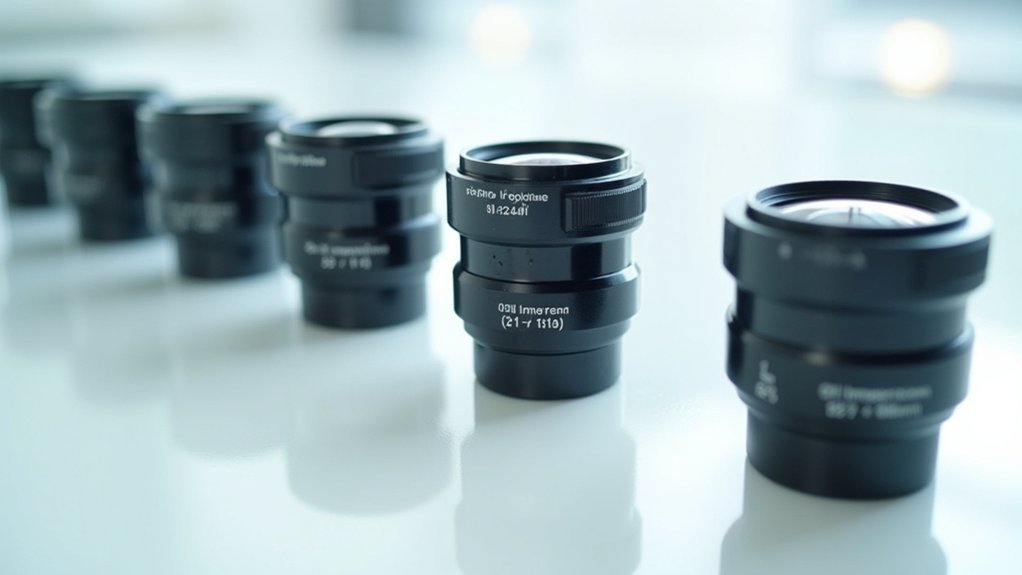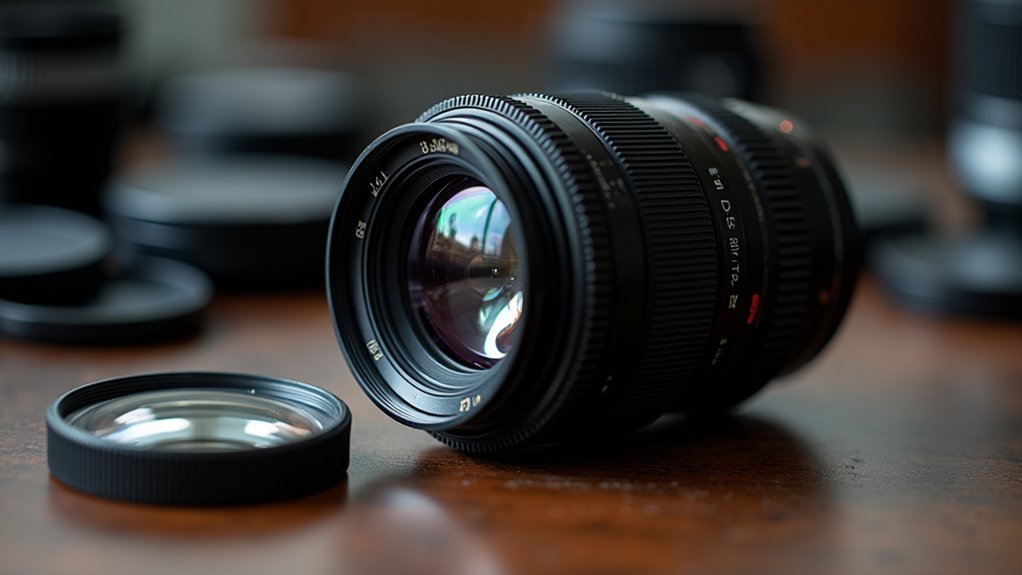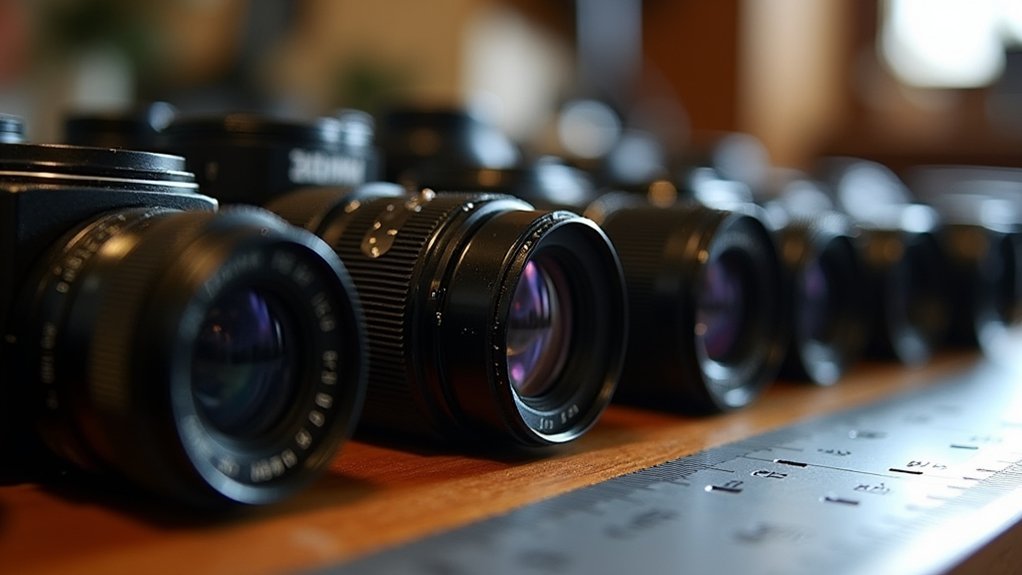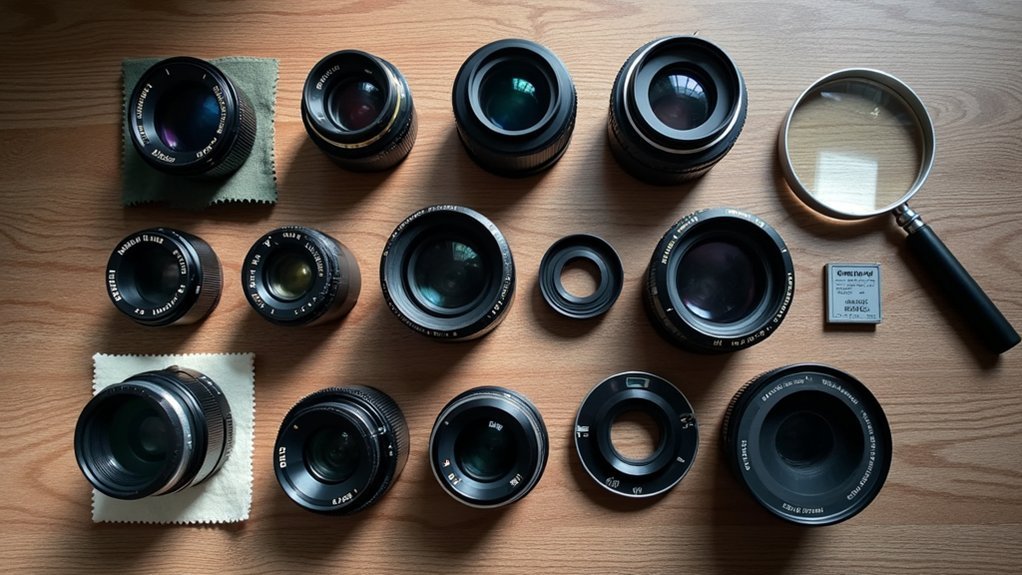When buying used microscope objectives, examine for scratches, fungus, and haze under bright light. Check the numerical aperture (NA) rating, thread compatibility, and working distance. Focus on reputable brands like Nikon, Zeiss, and Olympus, typically priced at 40-60% of retail. Verify mounting systems match your microscope’s specifications, and test performance with standard specimens before purchase. Quality objectives from trusted brands will serve you well for years with proper inspection techniques.
Essential Specifications to Evaluate in Used Microscope Objectives

When shopping for used microscope objectives, you’ll need to carefully evaluate several critical specifications to guarantee you’re getting a quality product.
Start by examining the optical clarity—a good choice will be free from scratches, haze, and fungus, making your specimens visually appealing.
Optical clarity reigns supreme—avoid objectives with scratches, haze, or fungus to ensure specimen brilliance.
Check the numerical aperture (NA) rating, as higher values deliver superior resolution and light-gathering capabilities.
Verify thread compatibility (RMS or DIN standards) with your microscope to avoid costly mistakes.
Don’t overlook working distance, especially if you’ll be observing thicker samples or living specimens.
Finally, research the manufacturer’s reputation and model history—established brands typically offer better performance and reliability.
This thorough buying guide will help you invest wisely in equipment that meets your imaging needs.
Identifying Quality Brands and Models for Long-Term Value
Why do experienced microscopists consistently recommend certain brands when shopping for used objectives? The answer lies in their proven track record of durability, optical performance, and resale value. Investing in reputable manufacturers like Nikon, Zeiss, and Olympus is much better than taking chances on lesser-known options.
| Brand | Known For | Best Models |
|---|---|---|
| Nikon | Superior optics | CFI60 series |
| Zeiss | Precision engineering | Epiplan-Neofluar |
| Olympus | Excellent clarity | UIS2 objectives |
| Leica | Color fidelity | HC series |
| Mitutoyo | Long working distance | Plan Apo series |
When evaluating used objectives, check for physical wear, fungus-free optics, and complete documentation. Purchasing from certified pre-owned programs offers additional security through warranties and quality assurance, protecting your investment for years to come.
Inspecting for Optical Damage and Performance Issues

When examining used objectives, you’ll need to carefully assess the lens surfaces for scratches, which can scatter light and degrade image quality even when they appear minor.
Hold the objective at different angles under bright light to spot any surface imperfections that mightn’t be immediately visible in normal lighting conditions.
Testing the light transmission by mounting the objective and viewing a standard specimen will reveal how these surface issues affect actual performance, giving you a real-world assessment of the objective’s optical integrity.
Surface Scratches Assessment
A thorough inspection of an objective’s glass surfaces represents one of the most critical steps in evaluating used microscope optics.
When examining potential purchases, you’ll need to use a bright flashlight to illuminate the objective at various angles, revealing scratches that might otherwise remain hidden.
Not all scratches impact performance equally. Deep abrasions cause problematic light scattering that degrades image quality, while fine surface marks may have minimal immediate effect but could worsen over time.
Don’t overlook signs of fungus or haze, which indicate poor storage conditions and can severely compromise optical clarity.
After visual inspection, always test the objective on a microscope to evaluate its actual working performance, including resolution and contrast. This practical assessment confirms whether any observed imperfections meaningfully affect the objective’s functionality.
Light Transmission Testing
Beyond surface assessment, light transmission quality often reveals issues invisible to the naked eye. When evaluating used objectives, you’ll want to test how efficiently they transmit light, with quality optics typically achieving 85-95% transmission rates.
Hold the objective up to a light source and look for any irregularities that might indicate internal damage. Check specifically for ghosting, flare, or color fringing—all signs of potential optical defects. These issues can considerably impact image clarity in your work.
If possible, use a photometer or spectrophotometer to quantify the transmission percentage. This step is particularly important for older objectives where coatings may have degraded over time.
Don’t skip this critical test—regular transmission evaluation helps you identify problematic optics before investing in equipment that won’t meet your performance needs.
Price Benchmarking: What You Should Expect to Pay
Understanding price ranges for used objectives helps you avoid both overpaying and missing great deals. Typically, quality used lenses sell for 40-60% of their original retail price, with popular models ranging from $200-$600 and specialty options commanding $800-$2,000.
Condition greatly impacts pricing—well-maintained lenses can fetch up to 80% of market value, while those with issues may drop to just 20%.
You’ll find better deals during off-peak seasons or after new model releases when prices naturally decline.
Before making a purchase, check recent sales on eBay and photography forums to establish current benchmarks. This research guarantees you’ll recognize fair pricing when you see it and positions you to negotiate effectively based on actual market conditions.
Compatible Mounting Systems and Thread Compatibility

When purchasing used microscope objectives, you’ll need to confirm that the mounting system matches your microscope’s specifications, particularly whether it uses RMS, DIN, or proprietary threading standards.
Thread variations between manufacturers can prevent otherwise excellent objectives from attaching to your equipment, as the 25mm diameter with 0.5mm pitch standard isn’t universal across all brands.
While adapters exist for some incompatible objectives, they often compromise optical alignment and performance, making native thread compatibility your best option for ideal results.
Lens Mount Compatibility Basics
The foundation of a successful used lens purchase lies in understanding mount compatibility between your camera body and potential lenses.
Your camera’s mount system—whether it’s Canon’s EF/RF, Nikon’s F/Z, or Sony’s E-mount—determines which lenses will physically attach and function properly.
When shopping for used lenses, always verify the exact mount type before purchasing.
Pay attention to thread size (measured in millimeters) for accessories like filters—common sizes include 49mm, 52mm, and 77mm.
These threads must match your accessories to avoid damage or vignetting.
While adapters can bridge compatibility gaps between different mounts, they sometimes compromise performance features like autofocus speed or aperture control.
Knowing your camera’s specific mount requirements will save you from costly mistakes and guarantee you’re investing in lenses you’ll actually be able to use.
Adapter Limitations Explained
While adapters can help solve mount compatibility issues, they come with significant limitations you should recognize before purchasing. Not all adapters fit every objective or microscope due to incompatible mounting systems, making pre-purchase verification crucial.
Thread compatibility is perhaps the most critical concern. Manufacturers use varying thread sizes (M25, M27, M36) and pitches, and mismatched threads will prevent proper attachment. Always check both the objective and adapter specifications to guarantee they’re designed to work together.
Consider the adapter’s weight limitations as well. Using objectives heavier than an adapter’s rating can cause mechanical failure or misalignment during use.
Additionally, some adapters may not support all objectives in your collection or might introduce optical distortions if poorly designed, potentially compromising image quality and focus precision.
Thread Variations Matter
Understanding microscope thread variations represents one of the most critical factors when purchasing used objectives.
You’ll need to verify the thread size, typically measured in millimeters, as compatibility varies considerably between camera brands and models.
Common mounting thread sizes include 37mm, 49mm, 52mm, 58mm, and 77mm. Before making any purchase, check your camera’s specifications to guarantee a proper fit.
Some objectives come with step-up or step-down rings, allowing compatibility with various filter sizes and expanding your accessory options.
Be cautious with proprietary thread designs from certain manufacturers, as these may not work with your system.
Always examine both the objective’s threads and your camera’s mounting area for wear or damage that could prevent secure attachment.
This simple inspection can save you from costly incompatibility issues.
Testing Methods Before Finalizing Your Purchase

How can you be certain that used objective is worth your money? Before committing to a purchase, employ proper testing methods to verify quality and performance.
| Test Method | What to Look For |
|---|---|
| Visual Inspection | Signs of wear, damage, fungus, or misalignment |
| Focus Test | Sharp images at various apertures |
| Compatibility Check | Correct mount type and required adapters |
| Hands-on Testing | Autofocus speed, accuracy, image stabilization |
| Research | Model reputation, common issues, user reviews |
Don’t skip the focus test—it’s essential for evaluating an objective’s ability to produce consistently sharp images across its aperture range. When possible, test the objective on your actual camera body to assess real-world performance. This hands-on approach will reveal any compatibility issues that specifications alone won’t show.
Where to Find Reliable Used Microscope Objectives Online
Five trusted marketplaces stand out when searching for quality used microscope objectives online. eBay offers a vast selection with detailed listings and seller ratings that help you assess reliability before purchasing.
For more specialized options, explore scientific equipment websites like LabX and MicroscopyList, which cater specifically to professionals and typically offer higher-quality used objectives.
Don’t overlook community resources. The Microscopy Society of America forums and Reddit’s microscopy subreddit feature member listings where you’ll find pre-owned objectives from fellow enthusiasts.
University surplus sales and laboratory liquidations also present excellent opportunities for quality finds at competitive prices.
When using mainstream platforms like Amazon or AliExpress, carefully verify seller ratings and always inquire about an objective’s condition, including optical clarity and return policies before finalizing your purchase.
Frequently Asked Questions
How to Write a Buying Guide?
To write a buying guide, you’ll need to research your target audience, organize clear sections with essential product details, include high-quality images, and guarantee easy navigation with actionable recommendations.
What Is the Purpose of a Buyer’s Guide?
A buyer’s guide serves to educate you about products, simplify your purchasing decisions, highlight quality options, and compare alternatives. It’s fundamentally your knowledgeable shopping companion that helps you make informed, confident purchases.
In Summary
When you’re buying used microscope objectives, remember to thoroughly check for damage, verify compatibility with your system, and test optical performance when possible. Stick with reputable brands, research fair market prices, and purchase from trusted sources with return policies. With careful evaluation, you’ll find quality used objectives that deliver excellent results for a fraction of new prices.





Leave a Reply